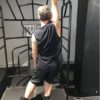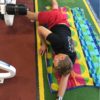Surf Fit News No.2 from Clive Rodell “Ask Clive”
In the last article I suggested a ‘simple’ one legged stance. That stance involved linear (looking to the front) and rotational (turning to the side and return) tasks.
How did you go??
If there were any instabilities, then they can be addressed by practicing the test moves and repeating them to gain better (motor) control. They may also lead us to other underlying issues that should be addressed. (I will add more when I get to the ‘Lower Cross syndrome’ in my next article).
If we go back to my comments re ‘upper cross and lower cross syndromes’ then imbalances in upper body or lower body posture can promote injury and also dysfunction.
Lets look at the shoulders and neck first. If we carry our head in a forward posture (usually due to tight chest and shoulder, plus scapula dysfunction), then we can get headaches and run the risk of neck damage or shoulder/rotator cuff injury.
The shoulder is possibly the most complicated area in the entire body.
Let’s not dwell on the latin names, but let’s look at it as ‘strings’ attached a both ends. If we pull a string tight and move the string back and forth without any hinderance, all should be good. If however, we deviate the line of that string and bend it around something else along the way, then it will not only hinder the free movement, but run the risk of ‘fraying’.
Muscles, ligaments and tendons can be viewed similarly. Anything that is diagnosed with the suffix ‘itis’ means inflamed/aggravated. So tendonitis is an inflamed tendon etc. Unless the trauma happened acutely (instantaneous injury), then it usually occurs because of misalignment.
In the shoulder area, as you can see from all the ‘strings’ in the diagrams, deviation of travel is undesirable. Alignment is crucial, misalignment (upper cross syndrome) is an injury risk.
Scapula dysfunction (the shoulder blade not functioning correctly) is often deemed the cause of shoulder issues. However, scapula dysfunction is most often than not caused by tight chest and shoulder muscles overpowering them and could be viewed as a secondary issue.
The rule to any shoulder blade rehabilitation is ‘lengthen, before you can strengthen’. Without allowing the shoulder to return to it’s natural position, the shoulder blade rehab is doomed.
Here are samples of some (there are more available) shoulder stretches to help, plus an exercise I personally developed to restore shoulder blade function (video on facebook ‘Clive’s Quality Training’ page)
https://www.facebook.com/
Here are samples of some (there are more available) shoulder stretches to help, plus an exercise I personally developed to restore shoulder blade function
Figure 1, chest (doorway) stretch.
Figure 2, Monkey hang stretch
Figure 3/4 Side-lying on tennis ball
Figure 5, ‘pass the baton’ stretch.
Having balance, both in the normal (stability) sense and the equality of skills sense can not only improve your surfing but dramatically decrease your risk of injury. Our brain often tends to think it’s as strong as our strengths, not our weaknesses.
Good luck! Any questions pls use the ‘Ask Clive’ App. HIT THIS LINK FOR FREE DOWNLOAD
Happy Surfing, Clive.





Recent Comments